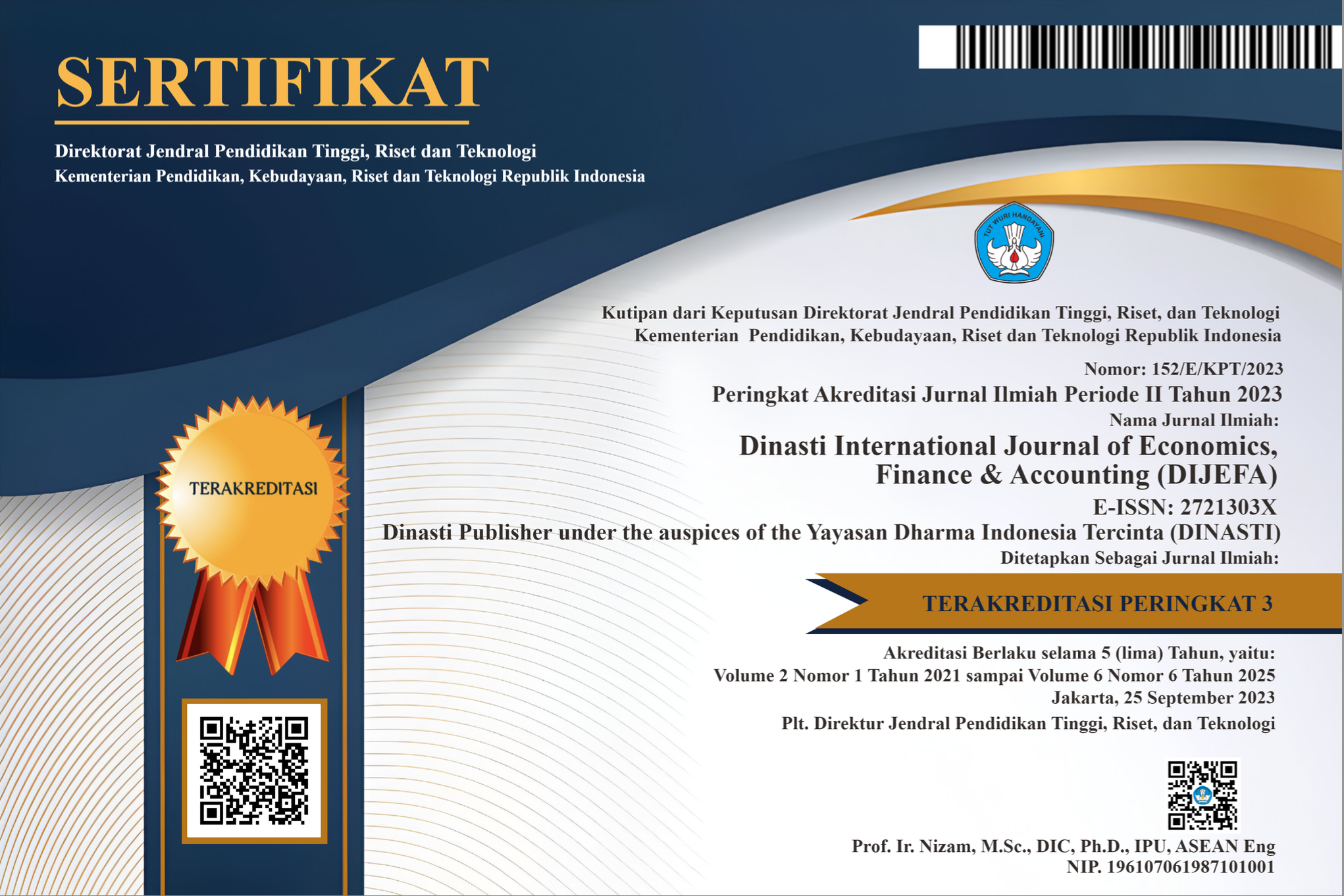ROA DETERMINANTS AND IMPACTS ON CAR (STUDY IN THE FIVE LARGEST PRIVATE BANKS IN INDONESIA 2009-2018)
DOI:
https://doi.org/10.38035/dijefa.v1i4.541Keywords:
Loan to Deposit Ratio, Net Interest Margin, Return On Assets, Capital Adequacy RatioAbstract
This study aims to analyze the effect of Loan to Deposit Ratio (LDR) and Net Interest Margin (NIM) on Return on Assets (ROA) and the influence of Loan to Deposit Ratio (LDR), Net Interest Margin (NIM) and Return on Assets (ROA) to the Capital Adequacy Ratio (CAR) of the five largest private banks in Indonesia in the 2009 - 2018 period. The sample used in this study consisted of 5 conventional private banks listed on the IDX. This study uses panel data obtained from Bank Indonesia reports and annual financial reports that have been audited and published by sample banks on the IDX By using the Fixed Effect Model with the help of Eviews 10, the F test shows that the LDR and NIM variables together have a significant effect on ROA of 77.69% while the remaining 22.31% is influenced by other factors not included in the research model. LDR, NIM and ROA variables together have a significant effect on CAR of 42.85% while the remaining 57.15% are influenced by other factors not included in this study where previously classical assumption tests such as Stationary, Multicollinearity, Test Heteroscedasticity and Autocorrelation test. Based on the results of the t test it was found that the LDR and NIM partially had no significant effect on ROA. LDR has a significant effect on CAR. Meanwhile, NIM and ROA partially had no significant effect on CAR
References
Adyani, Rahma Lyla. 2011. “Analisis Faktor-Faktor yang Mempengaruhi Profitabilitas (ROA). Skripsi.Universitas Diponegoro.”
Almilia, Luciana Spica dan Winny Herdiningtyas. (2005). Analisa Rasio CAMEL Terhadap Prediksi Kondisi Bermasalah Pada Lembaga Perbankan Periode 2000-2002. Jurnal Akuntansi dan Keuangan. Vol 7 No.2, Hal. 131-147.
Bachtiar, Yanivi (2014). Analisis Informasi Keuangan. Tanggerang Selatan: Universitas Terbuka.
Bank Indonesia, 1993. Surat Edaran Bank Indonesia Nomor: 26/5/BPPP/1993 (Online). (www.bi.go.id).
Bank Indonesia, 2003. Surat Edaran Peraturan Bank Indonesia Nomor: 5/PBI/2003 (Online). (www.bi.go.id).
Bank Indonesia, 2004. Surat Edaran Bank Indonesia Nomor: 6/10/PBI/2004 (Online). (www.bi.go.id).
Bank Indonesia, 2007. Surat Edaran Peraturan Bank Indonesia Nomor: 9/1/PBI/2007 (Online). (www.bi.go.id).
Bank Indonesia, 2010. Surat Edaran Peraturan Bank Indonesia Nomor: 12/19/PBI/2010 (Online). (www.bi.go.id).
Bank Indonesia, 2011. Surat Edaran Peraturan Bank Indonesia Nomor: 13/1/PBI/2011 (Online). (www.bi.go.id).
Brigham, Eugene F. and Joel F. Houston. 2011. Dasar-dasar Manajemen Keuangan. Edisi 11. Jakarta: Salemba Empat.
Dendawijaya, Lukman. 2009. Manajemen Perbankan. Jakarta: Ghalia Indonesia.
Diah Aristya. 2010. Analisis Pengaruh Ukuran Perusahaan Kecukupan Modal, Kualitas Aktiva Produktif (KAP) dan Likuiditas Terhadap Kinerja Keuangan (Studi Pada Bank Umum Syariah Di Indonesia Periode 2005-2009). Skripsi. Semarang: Universitas Diponegoro.
Harun, Usman. 2016. “Pengaruh Rasio-rasio Keuangan CAR, LDR, NIM, BOPO, NPL terhadap ROA”. Jurnal Riset Bisnis dan Manajemen. Vol. 4, No. 1, 67-82.Indonesia. Undang-Undang Pasal 1 ayat 2 No. 10 Tahun 1998 tentang Perbankan.
Jensen and Meckling. 1976. “Theory of the Firm: Managerial Behavior, Agency Costs and Ownership Structure”. Journal of Financial Economics, Vol. 3, 305-360.
Kuncoro, Mudrajad. 2009. “Metode Riset untuk Bisnis & Ekonomi”. Erlangga.
Kuncoro, Mudrajad dan Suharjono.2011. Manajemen Perbankan Teori dan Aplikasi. Yogyakarta: BPFE.
Mahardian. 2008. “Analisis Pengaruh Rasio CAR, BOPO, NPL, NIM dan LDR terhadap Kinerja Keuangan Perbankan (Studi Kasus Perusahaan Perbankan yang Tercatat di BEJ Periode Juni 2002-Juni 2007)”. Tesis. Universitas Diponegoro Semarang.
Myers, S.c. 1984. "Capital Structure Puzzle". Journal of Finance. 39 (3). July. pp 575-592.
Sakir, A. 2006. “Pengaruh Pecking Order Theory dalam Pengambilan Keputusan Pendanaan pada Perusahaan Perbankan Indonesia”. Jurnal Ekonomi dan Bisnis. Vol. 5, No. 2, 157-174.
Watts, and Zimmerman. 1986. Positive Accounting Theory. New York: Prentice Hall.
Downloads
Published
How to Cite
Issue
Section
License
Authors who publish their manuscripts in this journal agree to the following conditions:
- The copyright on each article belongs to the author(s).
- The author acknowledges that the Dinasti International Journal of Economics, Finance & Accounting (DIJEFA) has the right to be the first to publish with a Creative Commons Attribution 4.0 International license (Attribution 4.0 International (CC BY 4.0).
- Authors can submit articles separately, arrange for the non-exclusive distribution of manuscripts that have been published in this journal into other versions (e.g., sent to the author's institutional repository, publication into books, etc.), by acknowledging that the manuscript has been published for the first time in the Dinasti International Journal of Economics, Finance & Accounting (DIJEFA).


























































